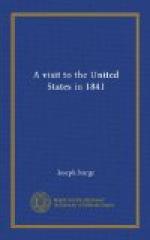The Genius of Universal Emancipation, an anti-slavery
paper which he had established at Baltimore. After
a residence in Baltimore of about six months, Garrison
was thrown into prison for an alledged libel upon
a northern slave-trader, whence he was liberated
on the payment of his fine by the benevolent Arthur
Tappan. Lundy continued his paper some time
longer in Baltimore, where he was subjected to brutal
personal violence from the notorious Woolfolk,
the great slave-dealer of that city. He afterwards
removed it to Philadelphia; and in 1834 made a
tour through the South Western States and Texas,
in which he encountered great dangers, and suffered
extreme hardships from sickness and destitution.
This journey was deemed by many an unprofitable
and hazardous experiment, but it proved of great
importance. He collected an immense amount
of facts, developing beforehand the grand slave-holding
conspiracy for revolutionizing Texas, and annexing
it to the American Union, as a slave territory.
These he published to the world on his return;
and it has justly been said of him, by John Quincy
Adams, that his exertions alone, under Providence,
prevented the annexation of Texas to the United
States. This bold and single-hearted pioneer died
not long since in the State of Illinois, whither
he repaired to take the place of the lamented
Lovejoy, who was murdered by a mob in that State,
in 1837.
“In 1831, Wm. Lloyd Garrison commenced, under great difficulties and discouragements, the publication of the Liberator, in Boston; and by the energy and earnestness of his appeals, roused the attention of many minds to the subject of slavery. Shortly after, a society was formed in Boston in favor of immediate emancipation. It consisted at first, if I remember right, of only twelve members. Previous to this, however, a society, embracing very similar principles, had been formed in Pennsylvania. In 1833, upwards of sixty delegates from several of the free States, met at Philadelphia; among them were Elizur Wright and Beriah Green, (who had been compelled to give up their Professorships in Western Reserve [Ohio] College, for their attachment to freedom,) Lewis Tappan, William Lloyd Garrison, Charles W. Denison, Arnold Buffum, Amos A. Phelps, and John G. Whittier. This Convention organized the American Anti-Slavery Society, proposing to make use of the common instrumentalities afforded by the Government and laws, for the abolition of slavery; at the same time, disavowing a design to use any other than peaceful and lawful measures.”
In some of the Southern States there are professing Christian churches who permit slave-holding, but disallow the selling of slaves, except with their own consent. Dr. Fussell informed me how this fair-seeming rule of discipline was frequently evaded. First, a church member wishing to turn his negroes into cash, begins by making their yoke heavier, and their life a burden. Next they are thrown in the way of decoy




